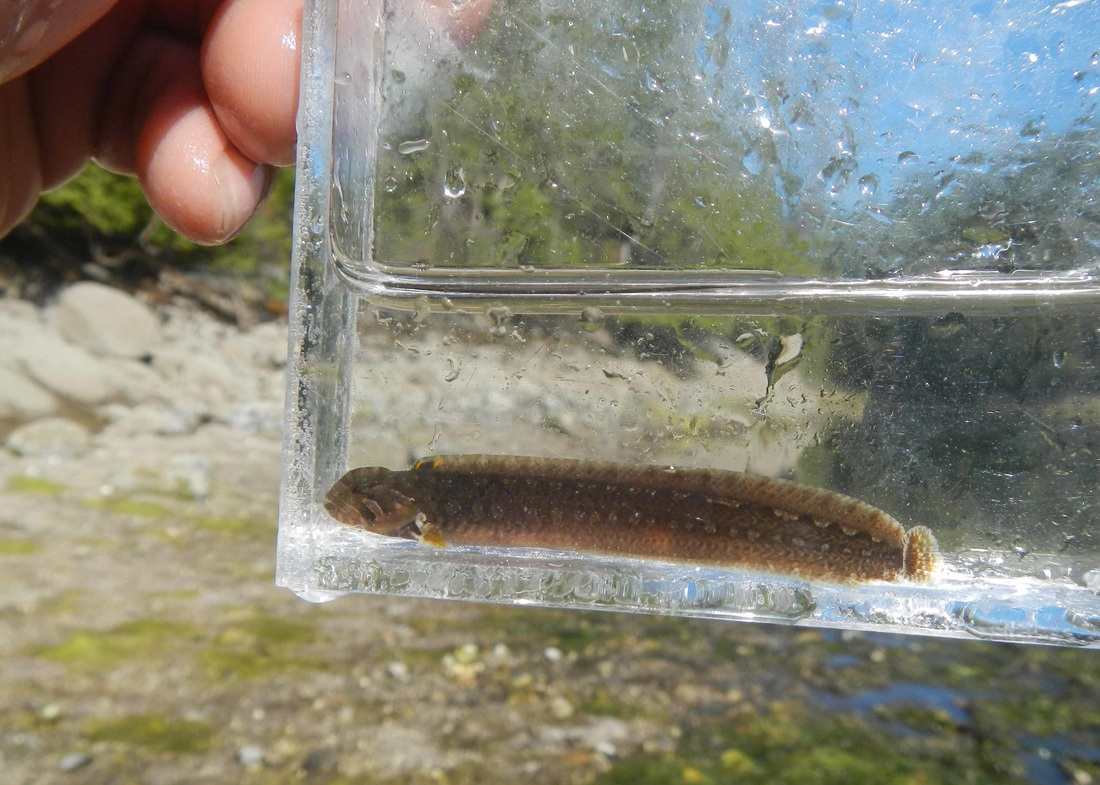Slender cockscomb • Anoplarchus insignis
Identification
Like other pricklebacks, the slender cockscomb has a long dorsal fin with sharp spines (hence the name "prickleback") as well as a long anal fin. "Cockscomb" comes from the somewhat fleshy crest at the top of its head. Its colouring is either dark or composed of broken or irregular dark and light patterning or mottling, and it usually has dark and light bars across the jaw. Very occasionally will individuals be partly or completely bright red. The maximum length of this fish is 12 cm.
Habitat & Range
As with all pricklebacks the slender cockscomb lives on the bottom. It is an elusive fish that hides in rocky crevices and amongst algae in the subtidal up to 30 m deep. Its range expends from the Bering Sea and Aleutian Islands to Norther California.
Similar Species
Pricklebacks and gunnels have similarly long and narrow body shapes; the most similar, however, is the high cockscomb (Anoplarchus purpurescens) which also has a fleshy head crest. Unlike the slender cockscomb, the high cockscomb commonly inhabits very shallow waters (less than 3 m) including intertidal tidepools, and may be found by beachcombers overturning rocks.
iNaturalist
https://www.inaturalist.org/taxa/213722-Anoplarchus-insignis
Like other pricklebacks, the slender cockscomb has a long dorsal fin with sharp spines (hence the name "prickleback") as well as a long anal fin. "Cockscomb" comes from the somewhat fleshy crest at the top of its head. Its colouring is either dark or composed of broken or irregular dark and light patterning or mottling, and it usually has dark and light bars across the jaw. Very occasionally will individuals be partly or completely bright red. The maximum length of this fish is 12 cm.
Habitat & Range
As with all pricklebacks the slender cockscomb lives on the bottom. It is an elusive fish that hides in rocky crevices and amongst algae in the subtidal up to 30 m deep. Its range expends from the Bering Sea and Aleutian Islands to Norther California.
Similar Species
Pricklebacks and gunnels have similarly long and narrow body shapes; the most similar, however, is the high cockscomb (Anoplarchus purpurescens) which also has a fleshy head crest. Unlike the slender cockscomb, the high cockscomb commonly inhabits very shallow waters (less than 3 m) including intertidal tidepools, and may be found by beachcombers overturning rocks.
iNaturalist
https://www.inaturalist.org/taxa/213722-Anoplarchus-insignis
References
Froese, R. and Capuli, E. E. Anoplarchus insignis Gilbert & Burke, 1912. FishBase. Accessed 22/02/2019.
Lamb, A. and Edgell, P. Coastal Fishes of the Pacific Northwest. Revised. (2010). Madeira Park, BC: Harbour Publishing. Pp. 121.
Lamb, A., and Hanby, B. (2005). Marine Life of the Pacific Northwest [electronic version]. Madeira Park, BC: Harbour Publishing.
Authors and editors of page
Kelly Fretwell (2019).
Froese, R. and Capuli, E. E. Anoplarchus insignis Gilbert & Burke, 1912. FishBase. Accessed 22/02/2019.
Lamb, A. and Edgell, P. Coastal Fishes of the Pacific Northwest. Revised. (2010). Madeira Park, BC: Harbour Publishing. Pp. 121.
Lamb, A., and Hanby, B. (2005). Marine Life of the Pacific Northwest [electronic version]. Madeira Park, BC: Harbour Publishing.
Authors and editors of page
Kelly Fretwell (2019).





